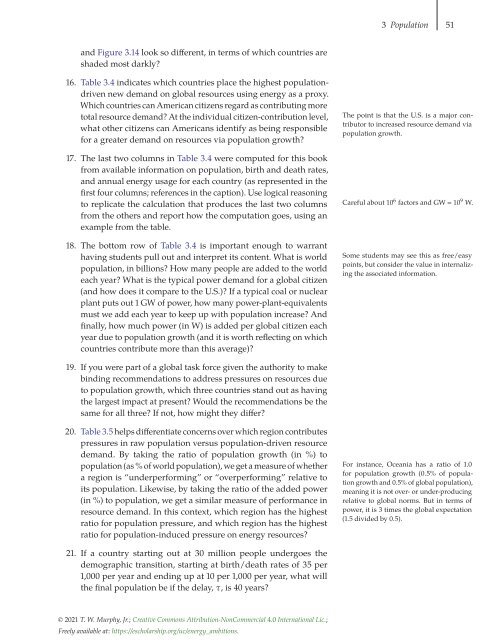Energy and Human Ambitions on a Finite Planet, 2021a
Energy and Human Ambitions on a Finite Planet, 2021a
Energy and Human Ambitions on a Finite Planet, 2021a
You also want an ePaper? Increase the reach of your titles
YUMPU automatically turns print PDFs into web optimized ePapers that Google loves.
3 Populati<strong>on</strong> 51<br />
<str<strong>on</strong>g>and</str<strong>on</strong>g> Figure 3.14 look so different, in terms of which countries are<br />
shaded most darkly?<br />
16. Table 3.4 indicates which countries place the highest populati<strong>on</strong>driven<br />
new dem<str<strong>on</strong>g>and</str<strong>on</strong>g> <strong>on</strong> global resources using energy as a proxy.<br />
Which countries can American citizens regard as c<strong>on</strong>tributing more<br />
total resource dem<str<strong>on</strong>g>and</str<strong>on</strong>g>? At the individual citizen-c<strong>on</strong>tributi<strong>on</strong> level,<br />
what other citizens can Americans identify as being resp<strong>on</strong>sible<br />
for a greater dem<str<strong>on</strong>g>and</str<strong>on</strong>g> <strong>on</strong> resources via populati<strong>on</strong> growth?<br />
The point is that the U.S. is a major c<strong>on</strong>tributor<br />
to increased resource dem<str<strong>on</strong>g>and</str<strong>on</strong>g> via<br />
populati<strong>on</strong> growth.<br />
17. The last two columns in Table 3.4 were computed for this book<br />
from available informati<strong>on</strong> <strong>on</strong> populati<strong>on</strong>, birth <str<strong>on</strong>g>and</str<strong>on</strong>g> death rates,<br />
<str<strong>on</strong>g>and</str<strong>on</strong>g> annual energy usage for each country (as represented in the<br />
first four columns; references in the capti<strong>on</strong>). Use logical reas<strong>on</strong>ing<br />
to replicate the calculati<strong>on</strong> that produces the last two columns Careful about 10 6 factors <str<strong>on</strong>g>and</str<strong>on</strong>g> GW = 10 9 W.<br />
from the others <str<strong>on</strong>g>and</str<strong>on</strong>g> report how the computati<strong>on</strong> goes, using an<br />
example from the table.<br />
18. The bottom row of Table 3.4 is important enough to warrant<br />
having students pull out <str<strong>on</strong>g>and</str<strong>on</strong>g> interpret its c<strong>on</strong>tent. What is world<br />
populati<strong>on</strong>, in billi<strong>on</strong>s? How many people are added to the world<br />
each year? What is the typical power dem<str<strong>on</strong>g>and</str<strong>on</strong>g> for a global citizen<br />
(<str<strong>on</strong>g>and</str<strong>on</strong>g> how does it compare to the U.S.)? If a typical coal or nuclear<br />
plant puts out 1 GW of power, how many power-plant-equivalents<br />
must we add each year to keep up with populati<strong>on</strong> increase? And<br />
finally, how much power (in W) is added per global citizen each<br />
year due to populati<strong>on</strong> growth (<str<strong>on</strong>g>and</str<strong>on</strong>g> it is worth reflecting <strong>on</strong> which<br />
countries c<strong>on</strong>tribute more than this average)?<br />
Some students may see this as free/easy<br />
points, but c<strong>on</strong>sider the value in internalizing<br />
the associated informati<strong>on</strong>.<br />
19. If you were part of a global task force given the authority to make<br />
binding recommendati<strong>on</strong>s to address pressures <strong>on</strong> resources due<br />
to populati<strong>on</strong> growth, which three countries st<str<strong>on</strong>g>and</str<strong>on</strong>g> out as having<br />
the largest impact at present? Would the recommendati<strong>on</strong>s be the<br />
same for all three? If not, how might they differ?<br />
20. Table 3.5 helps differentiate c<strong>on</strong>cerns over which regi<strong>on</strong> c<strong>on</strong>tributes<br />
pressures in raw populati<strong>on</strong> versus populati<strong>on</strong>-driven resource<br />
dem<str<strong>on</strong>g>and</str<strong>on</strong>g>. By taking the ratio of populati<strong>on</strong> growth (in %) to<br />
populati<strong>on</strong> (as % of world populati<strong>on</strong>), we get a measure of whether<br />
a regi<strong>on</strong> is “underperforming” or “overperforming” relative to<br />
its populati<strong>on</strong>. Likewise, by taking the ratio of the added power<br />
(in %) to populati<strong>on</strong>, we get a similar measure of performance in<br />
resource dem<str<strong>on</strong>g>and</str<strong>on</strong>g>. In this c<strong>on</strong>text, which regi<strong>on</strong> has the highest<br />
ratio for populati<strong>on</strong> pressure, <str<strong>on</strong>g>and</str<strong>on</strong>g> which regi<strong>on</strong> has the highest<br />
ratio for populati<strong>on</strong>-induced pressure <strong>on</strong> energy resources?<br />
For instance, Oceania has a ratio of 1.0<br />
for populati<strong>on</strong> growth (0.5% of populati<strong>on</strong><br />
growth <str<strong>on</strong>g>and</str<strong>on</strong>g> 0.5% of global populati<strong>on</strong>),<br />
meaning it is not over- or under-producing<br />
relative to global norms. But in terms of<br />
power, it is 3 times the global expectati<strong>on</strong><br />
(1.5 divided by 0.5).<br />
21. If a country starting out at 30 milli<strong>on</strong> people undergoes the<br />
demographic transiti<strong>on</strong>, starting at birth/death rates of 35 per<br />
1,000 per year <str<strong>on</strong>g>and</str<strong>on</strong>g> ending up at 10 per 1,000 per year, what will<br />
the final populati<strong>on</strong> be if the delay, τ, is 40 years?<br />
© 2021 T. W. Murphy, Jr.; Creative Comm<strong>on</strong>s Attributi<strong>on</strong>-N<strong>on</strong>Commercial 4.0 Internati<strong>on</strong>al Lic.;<br />
Freely available at: https://escholarship.org/uc/energy_ambiti<strong>on</strong>s.


















